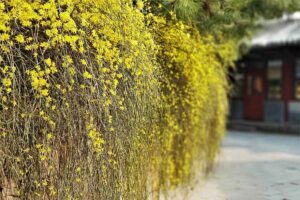
At the Master Gardener Help Desk we have received quite a few calls about the crazy forsythia blooming early. While it HAS been a crazy winter and all of our plants seem confused about whether or not to bud out, in this case the plant is NOT forsythia. Give forsythia a few more weeks.
The forsythia look-a-like is actually the old fashioned, oft-times forgotten Winter Jasmine, or Jasminum nudiflorum. The flower itself does look like a forsythia. However, forsythia’s four-petaled flowers occur in axils and may appear singly or in clusters. By contrast, jasmine’s single flowers have 5-6 petals, but who can tell passing by in a vehicle?
Further, forsythia is an upright bush, at least in most varieties, while jasmine is a low spreader. Jasmine twigs are flexible and green, sometimes making it appear evergreen, which it is not. It is at its best cascading down a hillside or over a wall.
The ability to root where the twigs touch the ground make this a great plant for quickly covering a bank. The down side of that type growth, in any plant, is that it can quickly become a trash collector for beer bottles, fast-food discards and other trash if sited near a roadside or high traffic area.
There is no good way to keep it cleaned out. It is much like wading into a raspberry patch, only without the thorns. Jasmine blooms sporadically over a long time period. If it gets cold again after a warm spell, emerging blooms will suspend their emergence until the weather warms. Hence, they give interest slowly over a month or two while forsythia gives a big show and in a few weeks has gone by.
Neither plant is too fussy about soil and will bloom in both sun and light shade, though they bloom better in full sun, if they do not dry out too much. If either fail to flower, you likely pruned too late or did not water enough in the latter half of summer. Both set flower buds on wood in the current season, for bloom next season.
If those buds dry out in our record-breaking heat summers, there will be few or no blooms next year. Both can be rejuvenated by cutting out thick old canes after bloom, but before the leaves come fully out, when you can see best. Both can take more drastic rejuvenation pruning.
If the patch becomes too weedy or just too old to bloom well, a severe cut-back will produce all new wood and better flowers and allow you to get into the patch and rogue out the poison ivy and poke weed the birds gifted you. Few plants are tough enough to take this kind of rejuvenation pruning.
After the plants leaf out they are easy to tell apart; the jasmine having tri-foliate leaves and the forsythia having lighter green toothed ovate leaves. Neither is showy out-of-season. Neither plant is native to this country but have been widely adopted, so are very commonplace or even naturalized. Both pre-date the Civil War!
Commonplace can sometimes overcome a lot of landscape challenges. There is something to be said for being adaptable and happy in a variety of conditions. If you want some early color, when few plants bloom, try a winter jasmine. Your ancestors would agree. Lexington, VA is a great place to see it cascading over walls.
– Barbara Leach, Horticulture Technician, VCE-Roanoke

